Appliance Efficiency
Standards
The DOE is in the process of approving new
standards for refrigerators and air conditioners under the
1987 National Appliance Energy Conservation
Act.
The potential to reduce electricity demand in
this area is especially high under the Bush Plan. Air
conditioners are the principal cause of the summer peak in
electricity demand and the need to construct additional
generating capacity. The highest potential impact of more
efficient air conditioning standards is a saving of up to
24,000 megawatts during the summer peak demand period by 2010.
This projection is based upon a 30 percent improvement in
energy efficiency for residential air conditioning units and a
20 percent improvement in the efficiency of commercial
units.
The WEFA Reference Case assumes that the
National Appliance Energy Conservation Act continues to be
implemented, albeit at a slower pace. The Bush Plan calls for
an extension of this Act over the longer
term.
Combined Heat and
Power
The potential for energy savings with
Combined Heat and Power (CHP) generation is estimated at 50
gigawatts under the most favorable circumstances for
implementation. Since most CHP installations are under the
control of municipal governments which do not pay taxes, the
use of tax credits and accelerated depreciation have not been
effective in stimulating the adoption of this technology.
Moreover, strict environmental regulations regarding permits
for new boilers in urban areas has also limited interest in
CHP. The Bush Energy Plan would provide tax credits and
relaxed environmental restrictions in permitting for CHP to
encourage its adoption in other markets. If this program could
attract private investment, a substantial amount of the
potential for CHP could be realized. Because CHP uses
significantly less fuel than traditional power generation,
associated emissions of greenhouse gases and air pollutants
are lower. In a model that substituted the targeted 50
giga-watts of CHP capacity for conventional capacity,
projections show that annual greenhouse emissions would be
reduced by 30 MMTCE and annual NOx emissions by hundreds of
thousands of tons.
The development of a large
CHP sector would have a major effect on commercial energy
markets. First, CHP could provide a significant share of the
generation of new energy. Second, the commercial demand for
space heating would be met in part by CHP. The heat production
of 10 gigawatts of additional CHP would displace about 100
trillion Btus of other heating fuel, assuming a 2000 Btu/kWh
heat credit for 5,000 hours of operation during the heating
season.
Review Tightening Corporate Average
Fuel Economy (CAFE) Standards
Although there
has been a lot of political pressure in the past few years to
raise the CAFE standards, they have been stymied by consumers’
unwillingness to choose efficiency over other attributes.
However, recent technological advances are such that engine
efficiency should be increasing over the long-term allowing
for substantial advances. A recent National Academy of
Sciences (NAS) study and review by the DOT may suggest some
increase in the standards over the long-term.
More
important is the issue of extending the existing CAFE to
minivans, SUVs and light-duty trucks. This would have a
significant impact on U.S. transportation fuel demand. In
fact, it is highly probable that the existing CAFE standards
will be applied to all passenger vehicles. Manufacturers have
already begun to make verbal commitments in attempt to
forestall the establishment of standards that carry financial
penalties for failure to comply. The Bush Energy Plan
specifically directs the DOT to look at market-based
mechanisms that may be substituted for some of the onerous
penalties in place today to produce
compliance.
Tax Credit for Fuel-Efficient
Vehicles
Given recent concerns about the size
of the medium-term budget surplus, any tax credit is likely to
be relatively small. Either it must apply to a small portion
of the vehicles or each vehicle would get a fairly small
credit. If just 10 percent of the cars sold in a given year
got a credit equal to 5 percent of their purchase price, this
could easily be equal to $1 billion, not an insignificant
amount in today’s budgetary climate.
If implemented, a tax credit could
raise the average efficiency of new automobiles, which would
raise the efficiency of the fleet at large. But since the
fleet at large expands by about 5 percent per year, raising
total fleet efficiency by 0.5 percent per year would mean
raising new car efficiency by about 10 percent per year
(depending on a variety of other factors, including vehicle
retirement, miles traveled, etc.). This is feasible, but
difficult if gasoline prices are low and consumers prefer
larger, more luxurious vehicles rather than smaller more
economical cars such as VW Beetles. Such a program could lower
the growth of gasoline demand, which was about 2 percent per
year in the 1990s, to 1.5 percent per year, other things being
equal. This would ease the strain on the refining sector and
reduce margins slightly for gasoline. Since the primary impact
on a global level would be slightly less demand for OPEC
resources, and the response of these countries would likely be
to enact slightly slower capacity expansion, the overall
market impact would be very small.
Income Tax Credit
for Purchase of New Hybrid or Fuel Cell Vehicles for
2002-2007
Of the alternative fueled
vehicles that might be candidates for tax credits, hybrid
electric vehicles and fuel cell vehicles are the ones proposed
by the NEP. Because latter still faces enormous technical
obstacles, any reasonable tax credit is unlikely to have a
significant impact on their utilization, particularly within a
short time period.

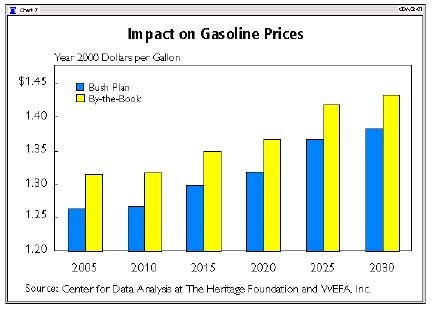
However, tax credits should
improve the market share of hybrid electric vehicles,
depending on the size of the credits. At this point, hybrid
electric vehicles remain relatively uneconomical but the
technology is currently moving into the stage of
commercialization. The WEFA base case assumes that this
technology will see a growing market share in the long-term
future (next three decades), and the tax credit will affect
that. However, as the technology improves and the use of
hybrids expands, Congress will almost certainly cut back on
the use of the tax credit because it will be deemed less
necessary and because it will put an increasing burden on the
budget.
Summary

Energy for a New
Century: Increasing Domestic Energy
Supplies
NEP Recommends the
President:
1. Direct the Secretaries of
Energy and the Interior to promote enhanced oil and gas
recovery from existing wells through new
technology.
2. Direct the Secretary of
Energy to improve oil and gas exploration technology through
continued partnership with public and private
entities.
3. Direct the Secretary of
the Interior to examine land status and lease stipulation
impediments to federal oil and gas leasing, and review and
modify those where opportunities exist (consistent with the
law, good environmental practice, and balanced use of other
resources).
• Expedite the
ongoing study of impediments to federal oil and gas
exploration and development, that have resulted from the
Energy Policy and Conservation Act.
• Review public lands
withdrawals and lease stipulations, with full public
consultation, especially with the residents of the affected
region, to consider modifications where
appropriate.
4. Direct the Secretary of
the Interior to consider economic incentives for
environmentally sound offshore oil and gas development, where
warranted by specific circumstances; explore opportunities for
royalty reductions, consistent with ensuring a fair return to
the public warranted for enhanced oil and gas recovery; and
provide incentives for reducing the risk associated with
production in frontier areas or deep gas formations and for
development of small fields that would otherwise be
uneconomic.
5. Direct the Secretaries of
Commerce and Interior to re-examine the current federal legal
and policy regime (statutes, regulations, and Executive
Orders) to determine if changes are needed regarding proposed
energy-related activities and locating of energy facilities in
the coastal zone and on the Outer Continental Shelf
(OCS).
6. Direct the Secretary of
the Interior to continue OCS oil and gas leasing and to
facilitate the approval of exploration and development plans
on predictable schedules. 7. Direct the Secretary of the
Interior to consider additional environmentally responsible
oil and gas development, based on sound science and the best
available technology, through further lease sales in the
National Petroleum Reserve-Alaska. Such consideration should
include areas not currently leased within the Northeast corner
of the Reserve.
8. Direct the Secretary of
the Interior to work with Congress to authorize the
exploration and, if resources are discovered, the development
of the 1002 Area of ANWR. Congress should require the use of
the best available technology and should require that
activities will result in no significant adverse impact to the
surrounding environment.
9. Direct the Secretary of
the Interior to work with Congress and the State of Alaska to
put in place the most expeditious process for renewal of the
Trans-Alaska Pipeline System rights-of-way to ensure that
Alaskan oil continues to flow uninterrupted to the West Coast
of the United States.
10. Direct the Secretary of
Energy to propose comprehensive electricity legislation that
promotes competition, protects consumers, enhances
reliability, promotes renewable energy, improves energy
efficiency, repeals the Public Utility Holding Company Act,
and reforms the Public Utility Regulatory Policies
Act.
11. Encourage Federal Energy
Regulatory Commission to use its existing statutory authority
to promote competition and encourage investment in
transmission facilities.
12. Direct the Department of
Energy to continue to develop advanced clean coal technology
by:
• Investing $2 billion
over 10 years to fund research in clean coal
technologies.
• Supporting a permanent
extension of the existing research and development tax
credit
• Directing federal
agencies to explore regulatory approaches that will
encourage advancements in environmental technol-
ogy.
13. Direct federal agencies
to provide greater regulatory certainty relating to coal
electricity generation through clear policies whose impact can
be readily understood when business decisions are
made.

17. Encourage the Federal
Energy Regulatory Commission and direct federal resource
agencies to make the licensing process for hydropower more
clear and efficient, while preserving environmental goals.
This includes:
• Supporting administrative
and legislative reform of the hydropower licensing
process.
• Directing federal resource
agencies to reach interagency agreement on conflicting
mandatory conditions for licensing before they submit their
conditions to FERC for inclusion in licensing
requirements.
• Encourage FERC to adopt
appropriate deadlines for its own actions during the licensing
process.
Analysis
Clean Coal
Technology Program Extension and
Enhancement
The Clean Coal Technology
Program is on the verge of bringing to market exciting new
capacity with the potential for significant increases in fuel
efficiency. The reference case includes a very aggressive
outlook for New Coal efficiency _ projecting an improvement of
approximately 30 percent from current capacity. (The current
average heat rate of 10,500, while new coal has an assumed
heat rate of 8,500.) The Bush Energy Plan's support of Clean
Coal Technology is critical for meeting the country's
efficiency and emission goals.
Oil and
Gas
These recommendations are
intended to increase the nation's available oil and gas
supply. They include:
• Promoting
enhanced oil and gas recovery from existing wells,
• Providing for increased
and /or lower cost access to lands,
• Economic incentives and
oil and gas exploration in certain areas,
• Promoting enhanced oil
and gas recovery from existing wells.
The NEP recommendation is
that "The president [should] direct the Secretaries of Energy
and the Interior to promote enhanced oil and gas recovery from
existing wells through new technology." This could result in
re-directing resources from non-energy producing areas to
enhanced oil and gas recovery research. Thus, over time, there
would be a gradual improvement in oil and gas recovery
technology.
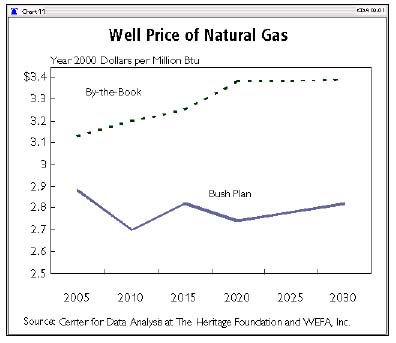

Regarding the lands of the
remaining unrecovered natural gas resource base of
approximately 1500 Tcf, about 15 percent is either subject to
a development moratorium until 2012 or subject to significant
limitations on drilling and development. Approximately 2
percent of the unrecovered resource base is located in highly
sensitive areas and is therefore not likely to be developed in
the foreseeable future. The areas subject to a moratorium on
development are largely offshore. These include the areas
offshore from the U.S. East Coast (21 Tcf), West Coast (31
Tcf), and portions of the Eastern Gulf Coast (24
Tcf).
WEFA estimates total
reserves in the Eastern Gulf of Mexico at approximately 50
Tcf, of which about 24 Tcf are off limits. In addition, other
areas offshore account for about 300 Tcf, making the total
Gulf of Mexico resources 350 Tcf. The issue of access to this
total area, therefore, is about producing just 15 percent of
that amount over the next 25 years.
Currently, the only area in
the Eastern Gulf of Mexico producing natural gas is the
Western Norphlet or Mobile Bay. Federal and state concerns
currently preclude the development of the Eastern Norphlet
(Destin Dome). However, a development plan has been filed for
the Destin Dome and, upon approval, this area could be in
production in one to three years. However, the reference case
assumes that Destin Dome is not developed. In its projections
there is also an area south of the Norphlet area known as
Section 181, of which the Administration and the State of
Florida recently agreed to make 1.9 million acres available
for lease/sale in 2001.
The Rocky Mountain area
accounts for approximately 25 percent of the remaining U.S.
resource base. About 7 percent of the Rocky Mountain area is
inaccessible and 25 percent of Rocky Mountain area resources
are subject to delayed development activity that will raise
the cost of drilling. WEFA estimates total reserves in the
Rocky Mountains at 382 Tcf. The issue of access in this area
is about producing just 10 percent of that amount over the
next 25 years.
In evaluating the impact of
the NEP recommendations regarding the U.S. resource base in
the Rocky Mountain area, the Eastern Gulf, Atlantic and
Pacific Offshore areas, WEFA has projected access to these
areas under the Bush Plan contingent upon agreements between
the Administration and the affected state(s). WEFA is not
aware of any efforts by the Administration of pursuing any
such agreements.

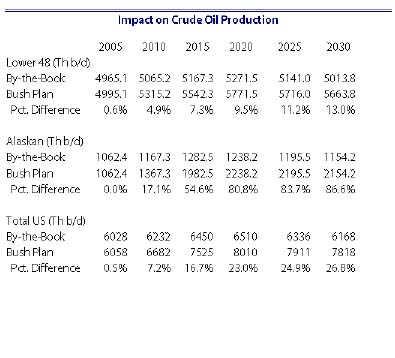
The WEFA analysis, however,
is premised on access agreements between the Administration
and the states. Accordingly, we have assumed that the Eastern
Gulf, Atlantic, and Pacific Offshore areas will be available
for lease sale in 2005. We have also assumed that the 25
percent of the Rocky Mountain area subject to high cost will
be treated in a manner similar to other areas. This is assumed
to reduce the development cost of wells by approximately 5
percent. The table presenting the model implementation below
summarizes the three cases. In the by-the-book case, we have
reduced access to the Rocky Mountain area to reflect recent
efforts of the EIA that would make areas that are off-limits
or have restricted access much larger than in the reference
case.
Economic Incentives
of Oil and Gas Exploration:
The NEP recommends that the
President direct the Secretary of the Interior to consider
economic incentives for environmentally sound offshore oil and
gas development where warranted by specific circumstances.
This would include exploring opportunities for royalty
reductions, consistent with ensuring a fair return to the
public, where warranted for enhanced oil and gas recovery. In
addition economic incentives would be given to reduce the
risks associated with production in frontier areas or deep gas
formations, and for the development of small fields that would
otherwise not be economical.
Royalty reductions have been
granted for some time with new leases in the deepwater areas
of the central and western Gulf. This recommendation suggests
applying this policy to other areas as well. The impact of
these recommendations could range from zero (continuation of
existing policies) to being very significant, depending on how
they are implemented. During the next three or four years,
royalty relief is unlikely to have any impact because gas
prices are likely to be well above the level needed to
stimulate exploration and production, and because of the
limited availability of rigs, crews, and experienced
geologists.
Measures to
Increase Drilling in the United States
Outside of the politically
sensitive areas of ANWR and offshore California, the primary
obstacles to new oil production in the United States are
economic and geological. Many of the NEP proposals will help
slightly, but they will not alleviate the high cost of oil
production in the United States, nor the shortages of
personnel and equipment.
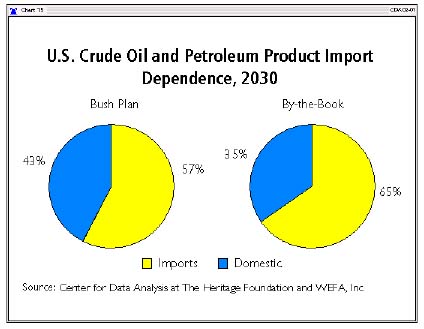
For example, improving oil
and gas exploration technology will make only a minimal
difference from the reference case. The effort to improve
exploration technology is a continuation (and perhaps an
enhancement) of an effort that was begun in the 1990's under
President George H. W. Bush. The intent has been to help
smaller, independent companies gain access to newer
technologies that lower costs and improve recovery. Although
it is difficult to quantify the effects of this effort, it is
worth noting that oil production in the lower 48 states
stopped declining in 1994 and plateaued thereafter, until the
oil price collapse.
Measures such as royalty
relief would certainly have an impact, depending on the size
of the tax relief. However, it is difficult to estimate the
precise impact they may have, and the impact would be minimal.
On a global scale, it would be minor, but the slightly higher
U.S. oil production would reduce the trade deficit by a few
percentage points over the long run.
Impact of Drilling
in ANWR and Offshore California
These are the geographic
areas where political opposition to drilling is strongest. In
the most optimistic case, implementation of the Bush Plan
would allow for increased drilling in 2002. As a result,
production might be as much as 400 tb/d higher by 2010 (of
which 250 tb/d would come from California, conditioned on an
agreement between the Administration and the state, and 150
tb/d from ANWR), and 1,500 tb/d higher by 2020 (of which 500
tb/d from California, pursuant to an agreement between the
Administration and the state, and 1,000 tb/d would come from
ANWR). WEFA is not aware of any efforts by the Administration
to pursue drilling in offshore California. The impact on the
world oil market would be fairly small. In terms of global
production, the increase would be less than 1.25 percent.
However, this would be 6 percent of U.S. oil imports in 2010
and 18 percent in 2020, under the most optimistic assumptions,
so there would be a moderate macroeconomic impact from the
improved trade balance. However, it is unlikely that the
necessary political compromise will be reached that will allow
drilling to begin so quickly in these sensitive regions. This
affects the estimate for 2010 in particular, as the production
growth projected for the early years is quite strong. If
drilling begins in 2005, then production in 2010 will still be
in the early part of the S-curve representing production, and
so could be much lower than anticipated. Such a delay would
not affect production projected for 2020, though, since this
is a period in which production is expected to
plateau.
Nuclear
One of the most substantive
recommendations of the NEP is that the Price-Anderson Act be
extended. The NEP also recommends supporting the expansion of
nuclear safety in the United States through safety precautions
and expediting applications for licensing new
advanced-technology nuclear reactors which have more safety
features. The recommendation to improve public education on
nuclear safety would support the re-licensing of nuclear power
plants.
The reference case assumes
that most nuclear power plant licenses will be extended five
years. In the Bush Plan it is assumed that these licenses will
be extended 10 years. In the by-the-book scenario, nuclear
units would not be re-licensed.
Reform Hydro
Re-licensing
The reference case assumes
all hydro capacity would be relicensed. The Bush Plan would
improve the timeliness and reduce the cost of
relicensing.
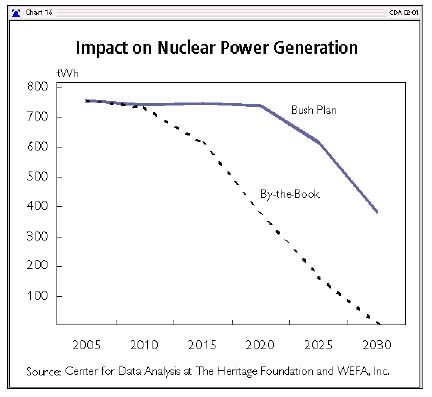
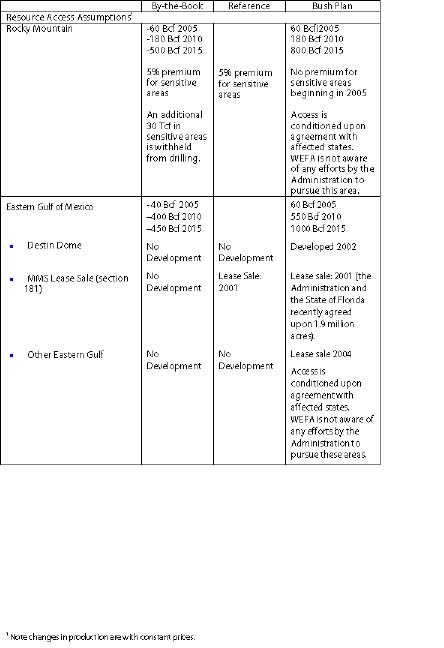
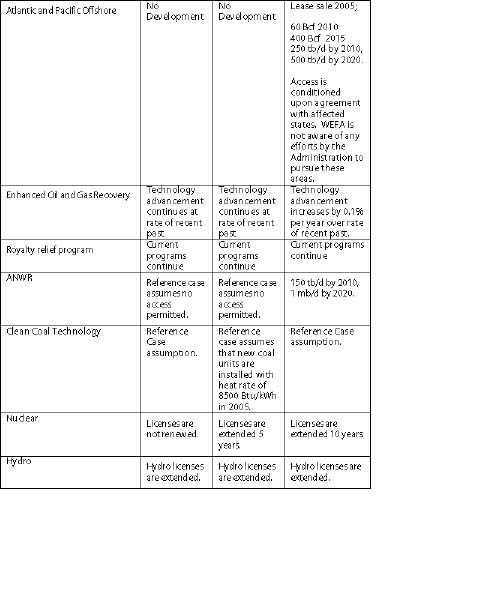
Nature's Power:
Increasing America's Use of Renewable and Alternative
Energy
NEP Recommends the
President:
1. Direct the Secretaries of
the Interior and Energy to re-evaluate access limitations to
federal lands in order to increase energy production through
renewable resources, such as biomass, wind, geothermal, and
solar.
2. Include an increase of
$39.2 million in the FY 2002 budget amendment for the
Department of Energy's Energy Supply account that would
provide increased support for research and development of
renewable energy resources.
3. Direct the Secretary of
Energy to conduct a review of current funding and historic
performance of renewable energy and alternative energy
research and the development of programs in light of the
recommendations of this report. Based on this review, the
Secretary of Energy should then be directed to propose
appropriate funding for research and development programs that
are performance-based and are modeled as public-private
partnerships.
4. Direct the Secretary of
the Treasury to work with Congress to design legislation to
expand the Section 29 tax credit to make it available for new
landfill projects for methane. The credit could be tiered,
depending on whether or not a landfill is already required by
federal law to collect and flare its methane
emissions.
5. Direct the Secretary of
the Interior to determine ways to reduce the delays in
geothermal lease processing as part of the permitting review
process.
6. Direct the Administrator
of the Environmental Protection Agency to develop a new
renewable energy partnership program to help companies more
easily buy renewable energy, and receive recognition for the
environmental benefits of their purchase, and promote consumer
choice programs that increase consumers' knowledge about the
environmental benefits of purchasing renewable
energy.
7. Direct the Secretary of
the Treasury to work with Congress to develop legislation to
extend and expand tax credits for electricity produced using
wind and biomass. (In addition, the NEP urges the acceptance
of the budget request to extend the present 1.7 cents
per-kilowatt-hour tax credit for electricity produced from
wind and biomass; expand eligible biomass sources to include
forest-related sources, agricultural sources, and certain
urban sources; and allows a credit for electricity produced
from biomass co-fired with coal.)
8. Direct the Secretary of
the Treasury to work with Congress to develop legislation to
provide a new 15 percent tax credit for residential solar
energy property, up to a maximum credit of $2,000.
9. Direct the Secretaries of
the Interior and Energy to work with Congress to develop
legislation to use an estimated $1.2 billion of bid bonuses
from the environmentally responsible leasing of ANWR to fund
research or alternative and renewable energy resources,
including wind, solar, geothermal, and biomass.
10. Direct the Secretary of
the Treasury to work with Congress to continue the ethanol
excise tax exemption.
11. Direct the Secretary of
Energy to develop next-generation technology—including
hydrogen and fusion, and to
• Develop a public
information campaign that communicates the benefits of
alternative forms of energy, including hydrogen and
fusion.
• Focus research and
development efforts on integrating current programs regarding
hydrogen, fuel cells, and distributed energy.
• Support legislation
reauthorizing the Hydrogen Energy Act.
12. Direct the Secretary of
the Treasury to work with Congress to develop legislation to
provide for a temporary income tax credit that would be
available for the purchase of new hybrid or fuel-cell vehicles
between 2002 and 2007.
13. Direct the Administrator
of the Environmental Protection Agency to issue guidance to
encourage the development of well-designed CHP units that are
both highly efficient and have low emissions, and to shorten
the time needed to obtain each permit, provide certainty to
industry by ensuring consistent implementation across the
country, and encourage the use of these cleaner, more
efficient technologies. Analysis
Expanding Section
29 Tax Credit To Make It Available for New Landfill Methane
Projects
In 1999 approximately 2.1
million tons of methane were recovered from landfills and used
as energy compared to just 0.7 million in 1990.
The Federal Section 29 (of
the Internal Revenue Code) tax credit for alternative energy
sources, including landfill gas, was added to the tax code as
part of the Crude Oil Windfall Profits Act of 1980 and
provides an inflation-adjusted credit that currently is
equivalent to $6.00 per barrel of oil equivalent of qualified
fuels. However, the tax credit for new facilities expired on
June 30, 1998, and, absent a similar subsidy, the number of
additional landfill gas-to-energy projects that are
commercially viable is limited. The extension of these tax
credits could result in approximately 0.15 million metric tons
of additional methane recovered that could be used for energy
from landfills. While subsidies would be helpful, a
significant part of this recovery would occur as a result of
the EPA's New Source Review Standards and Emission Guidelines,
which require all landfills with more than 2.5 million metric
tons of waste in place and annual emissions of non-methane
volatile organic compounds (NMVOCs) exceeding 50 metric tons
to collect and burn their landfill gas, either by flaring or
as an energy resource.
Use of Bid Bonuses
from ANWR for Research and Development on Renewable Energy
Sources
This is clearly an attempt
to improve the acceptability of drilling in ANWR by offering a
trade off to environmentalists, who are the primary opponents.
However, given the virulence of the opposition, the proposal
to increase research and development spending for alternative
and renewable energies is not likely to lessen the
environmentalists opposition to opening up the ANWR for
drilling.
The NEP estimates that $1.2
billion would be available in tax credits . Assuming this
amount would be spent over a number of years, probably a
decade or so, this proposal adds an additional
$100 million to $150 million
per year in tax credits that would be available. Such an
amount is less than has been spent throughout the past two
decades, having at most only a marginal impact on the supply
of those fuels. This being the case, it is unlikely that the
extension of tax credits would have a significant
effect.
Continuation of the
Ethanol Excise Tax Exemption is assumed in the WEFA's
Analysis.
Summary
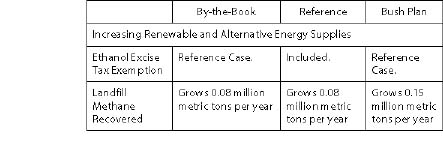
America's Energy
Infrastructure: A Comprehensive Delivery
System
NEP Recommends the
President:
1. Direct the Secretary of
Energy to work with the Federal Energy Regulatory Commission
(FERC) to improve the reliability of the interstate
transmission system and to develop legislation providing for
enforcement by a self-regulatory organization subject to FERC
oversight.
2. Direct the Secretary of
Energy to expand the department's research and development on
transmission reliability and superconductivity.
3. Direct the Secretary of
Energy to authorize the Western Area Power Administration to
explore relieving the "Path 15" bottleneck through
transmission expansion financed by nonfederal
contributions.
4. Direct the appropriate
federal agencies to take actions to remove constraints on the
interstate transmission grid to allow our nation's electricity
supply to meet the growing needs of our economy. To this end,
he should
• Direct the Secretary of
Energy, by December 31, 2001, to examine the benefits of
establishing a national grid, identify transmission
bottlenecks, and identify measures to remove transmission
bottlenecks.
• Direct the Secretary
of Energy to work with FERC to relieve transmission
constraints by encouraging the use of the incentive of rate
making proposals.
• Direct the federal utilities to
determine whether transmission expansions are necessary to
remove constraints. The Administration should review the
Bonneville Power Administration's (BPA's) capital and
financing requirements in regard to its membership in a
Regional Transmission Operator (RTO), and to ascertain
whether additional Treasury financing appears warranted or
necessary in the future, the Administration should seek an
increase in BPA's borrowing authority.
• Direct the
Secretary of Energy, in consultation with appropriate
federal agencies and state and local government officials,
to develop legislation to grant the federal government
authority to obtain rights-of-way for electricity
transmission lines, with the goal of creating a reliable
national transmission grid. Similar authority already exists
for natural gas pipelines in recognition of their role in
interstate commerce.
5. Direct the Secretary of
the Interior to work with Congress and the State of Alaska to
put in place the most expeditious process for renewal of the
Trans-Alaskan Pipeline System lease to ensure that Alaskan oil
continues to flow uninterrupted to the West Coast of the
United States.
6. Direct the Secretaries of
Energy and State, in coordination with the Secretary of the
Interior and the Federal Energy Regulatory Commission, to work
closely with Canada, the State of Alaska, and all other
interested parties to expedite the construction of a pipeline
to deliver natural gas to the lower-48 states. This should
include proposing to Congress any changes or waivers of law
pursuant to the Alaska Natural Gas Transportation Act of 1976
that may be required.
7. Support legislation to
improve the safety of natural gas pipelines, protect the
environment, strengthen emergency preparedness and
inspections, and bolster enforcement.
8. Direct relevant agencies
to continue their interagency efforts to improve pipeline
safety and expedite pipeline permitting in an environmentally
sound manner and encourage FERC to consider improvements in
the regulatory process that governs the approval of interstate
natural gas pipeline projects.
9. Direct the Administrator
of the EPA to study opportunities to maintain or improve the
environmental benefits of state and local "boutique" clean
fuel programs, and to explore ways to increase the flexibility
of the fuels distribution infrastructure, improve fungibility,
and provide added gasoline market liquidity. In conducting
this study, the Administrator shall consult with the
Departments of Energy and Agriculture, and other agencies as
needed.
10. Direct the Administrator
of the EPA and the Secretary of Energy to take steps to ensure
that America has adequate refining capacity to meet the needs
of consumers. To that end he should
• Provide more regulatory
certainty to refinery owners and streamline the permitting
process where possible to ensure that regulatory overlap is
limited. • Adopt comprehensive regulations (covering more than
one pollutant and requirement) and consider the rules'
cumulative impacts and benefits.
11. Direct the Administrator
of the EPA, in consultation with the Secretary of Energy and
other relevant agencies, to review New Source Review
regulations, including administrative interpretation and
implementation, and report to the President within 90 days on
the impact of the regulations on investment in new utility and
refinery generation capacity, energy efficiency, and
environmental protection.
12. Direct the Attorney
General to review existing enforcement actions regarding New
Source Review to ensure that they are consistent with the
Clean Air Act and its regulations.
13. Acquire support for his
budget proposal to provide $8 million to maintain the
two-million-barrel Northeast Heating Oil Reserve. Operated by
the private sector, the reserve helps to ensure that adequate
supplies of heating oil in the event that colder than normal
winters occur in the Northeast United States.
Analysis
Electricity
Restructuring Proposals
An essential component of
the NEP recommendations involves the improvement of the
nation's electricity infrastructure. With the increasing
deregulation of electricity markets, growing emphasis is being
placed on the nation's transmission system. In the new
scenario, electric power can be generated in virtually any
location and then transported to the points of demand. For
this process to work, it is essential that the transmission
system be reliable.
There are a number of key
issues associated with transmission system reliability. One
such issue is congestion management. Congestion management
must be addressed with regard to the transmission grid. This
refers to the management of electricity flow so that the
lowest priced electricity can be moved to the markets that
need it. Path 15 in California is a case in point. During this
past winter, transmission bottlenecks prevented a sufficient
electricity flow from Southern California to the northern part
of the state where power was desperately needed. It is feared
that this situation will be repeated in reverse this summer,
as additional power supplies will be required in the future.
Congestion management can be improved in two ways. One way is
to improve the flow of electricity within the existing
transmission system. This can be accomplished by removing
restrictions on the interstate flow of electricity along
existing transmission lines. Power suppliers should be granted
access to transmission lines at fair and reasonable rates. In
addition, regulatory authorities must give utilities an
incentive to invest in the maintenance of their transmission
systems. Rate structures should make investing in transmission
systems as profitable as other utility investments are.
Improvement of existing transmission facilities can lead to
significant reductions in line losses. Current estimates of
line losses are in the 6 percent range. Transmission system
upgrades can reduce line losses to the 3 percent
range.
The nation's flow of
electricity can also be improved by expanding its transmission
system. The Secretary of Energy should advocate a national
policy of increased rights of way for transmission lines. The
process of transmission line siting should be streamlined and
the national interest should be the criterion for approval.
Tax incentives should be offered to encourage electric
utilities to collaborate with telecommunications firms to
share transmission facilities. Shared fiber optic cabling will
not only improve the reliability of the transmission system
but will reduce line losses as well.
Improvement of the nation's
transmission system through both better maintenance of the
existing system and expansion should be a very high priority
of national energy policy. The result will be both increased
reliability and lower electricity prices.
WEFA'S electric utility
model projects additional capacity requirements in each
utility planning region based upon the region's expected
generation requirements for the year and the optimal capacity
for the region. Optimal capacity is defined as that which
would assure a desired reserve margin, while "expected
generation" is calculated based upon projected electricity
demand, transmission losses, and inter-regional transfers of
power. If the optimal capacity calculation implies an increase
in generating capacity that is greater than a specified
magnitude, then capacity is added to the region.
If the policies advocated
above are adopted, transmission losses will be reduced and
inter-regional transfers of power will increase. As a result,
there will be a reduced need for additional generation, and
retail electricity prices will be lower. This will have a
pronounced effect in California and the Northeast states that
rely upon significant amounts of imported power.
To Augment
Refining, the NEP Recommends the
Following:
Expedite permitting, develop
a multi-pollutant strategy, review New Source Review
regulations, and improve fungibility of new clean
products
The availability of clean
fuels, particularly new petroleum product formulas, has
certainly been constrained by the lack of adequate refinery
upgrading capacity. The impact has been to increase margins
for reformulated gasoline, but this has been done only for
brief periods at the local level. During the past year the
overall impact has been to add about $4/barrel to the cost of
reformulated gasoline, as compared to crude oil.
Obstacles to the
construction of new refineries are not the primary problem,
however. A combination of refiners' desire to avoid
overbuilding their upgrading capacity and the limited
availability of qualified engineers and equipment is
depressing capacity expansion and upgrading. Uncertainty about
regulations regarding upgrading and expansion is another,
though smaller, factor in preventing augmented upgrading
capacity. More than concerns about New Source Review
regulations the higher costs of fuel and labor in the United
States have discouraged the construction of new refineries.
(OPEC countries typically charge a refinery $.50/Mcf for
natural gas.)
The recent petroleum product
volatility was due in part to the poorly designed regulations
for the use of new petroleum products. The large number of
different required formulas (which varied by region and
season) has increased regulatory uncertainty and logistical
difficulties. The implication behind the NEP recommendation is
that these regulations would be redesigned in such a way as to
reduce price volatility. If successful, this would prevent the
kinds of spikes in margins that have occurred recently. This
proposal will improve the situation slightly, and could lower
gasoline margins as much as $2 a barrel in the most extreme
case.
Summary
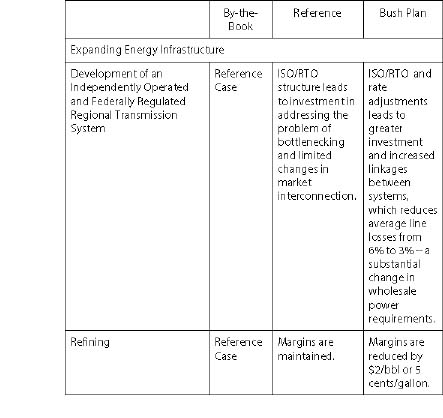
Strengthening Global Alliances: Enhancing
National Energy Security and International
Relationships
NEP Recommends the
President:
1. Make energy security a
priority of U.S. trade and foreign policy.
2. Support initiatives by
Saudi Arabia, Kuwait, Algeria, Qatar, the UAE, and other
suppliers to open up areas of their energy sectors to foreign
investment.
3. Direct the Secretaries of
State, Energy, and Commerce work to improve dialogue among
energy producing and energy consuming nations.
4. Direct the Secretaries of
State, Commerce, and Energy to continue supporting American
energy firms competing in markets abroad and use our
membership in multilateral organizations, such as the
Asia-Pacific Economic Cooperation (APEC) forum, the
Organization for Economic Cooperation and Development (OECD),
the World Trade Organization (WTO) Energy Services
Negotiations, the Free Trade Area of the Americas (FTAA), and
our bilateral international relationships to design and
implement a system of clear, open, and transparent rules and
procedures governing foreign investment to level the playing
field for U.S. companies overseas and to reduce barriers to
trade and investment.
5. Direct the Secretaries of
Commerce and Energy, and the U.S. Trade Representative, to
support a sectoral trade initiative to expand investment and
trade in energy-related goods and services that will enhance
exploration, production, and refining, and the development of
new technologies.
6. Direct the Secretaries of
State, Treasury, and Commerce to initiate a comprehensive
review of sanctions. Energy security should be one of the
factors considered in such a review.
7. Direct the Secretaries of
State, Commerce, and Energy to engage in a dialogue through
the North American Energy Working Group to develop coordinated
energy integration among Canada, Mexico, and the United States
and to identify areas of cooperation, that are fully
consistent with the countries' respective
sovereignties.
8. Direct the Secretaries of
Energy and State, in consultation with the Federal Energy
Regulatory Commission, to review their respective oil, natural
gas, and electricity cross-boundary "presidential permitting"
authorities, and to propose reforms, as necessary, in order to
make their own regulatory regimes more compatible for
cross-border trade.
9. Direct the Secretaries of
Energy and State, coordinating with the Secretary of the
Interior and the Federal Energy Regulatory Commission, to work
closely with Canada, the State of Alaska, and all other
interested parties to expedite the construction of a pipeline
to deliver natural gas to the lower-48 states. This should
include proposing to Congress any changes or waivers of law
that may be required with regard to the Alaska Natural Gas
Transportation Act of 1976.
10. Direct the Secretaries
of State and Commerce to conclude negotiations with Venezuela
on a Bilateral Investment Treaty and propose formal energy
consultations with Brazil to improve the climate for a growing
level of energy investment flow between the United States and
each of these countries.
11. Direct the Secretaries
of Energy, Commerce, and State to work through the Summit of
the Americas' Hemispheric Energy Initiative to develop
effective and stable regulatory frameworks and foster reliable
supply sources of all fuels within the region.
12. Direct the Secretaries
of State, Energy, and Commerce to reinvigorate the U.S.-Africa
Trade and Economic Cooperation Forum and the U.S.-African
Energy Ministerial process; deepen bilateral and multilateral
engagement to promote a more receptive environment for U.S.
oil and gas trade, investment, and operations; and promote
geographic diversification of energy supplies, addressing such
issues as transparency, sanctity of contracts, and
security.
13. Direct the Secretaries
of State, Commerce, and Energy to support more transparent,
accountable, and responsible use of oil resources in African
producer countries to enhance the stability and security of
trade and investment environments.
14. Direct the Secretaries
of State, Commerce, and Energy to support the BTC oil pipeline
as it demonstrates its commercial viability.
15. Direct the Secretaries
of Commerce, State, and Energy to continue working with
relevant companies and countries to establish the commercial
conditions that will allow oil companies operating in
Kazakhstan the option of exporting their oil via the BTC
pipeline.
16. Direct the Secretaries
of State, Commerce, and Energy to support the efforts of
private investors and regional governments to develop the Shah
Deniz gas pipeline as a way to help Turkey and Georgia
diversify their natural gas supplies and help Azerbaijan
export its gas via a pipeline that will continue to diversify
secure energy supply routes.
17. Direct appropriate
federal agencies to complete the current cycle of oil spill
response readiness workshops and to consider further
appropriate steps to ensure the implementation of the
workshops' recommendations.
18. Direct the Secretary of
State to encourage Greece and Turkey to link their gas
pipeline systems to allow European consumers to diversify
their gas supplies by purchasing Caspian gas.
19. Direct the Secretaries
of Commerce, Energy, and State to continue and expand their
commercial dialogue with Kazakhstan, Azerbaijan, and other
Caspian states to provide a strong, transparent, and stable
business climate for the energy commerce and related
infrastructure projects.
20. Direct the Secretaries
of State, Commerce, and Energy to expand discussions with
Russia on energy and the investment climate.
21. Direct the Secretaries
of Commerce, State, and Energy to assist U.S. companies in
their dialogue with Russian officials on the investment and
trade climate to encourage reform of the Production Sharing
Agrement law and other regulations and related tax provisions
and to promote general improvements in the overall investment
climate. This will help expand private investment
opportunities in Russia and will increase the international
role of Russian firms.
22. Direct the Secretaries
of State, Commerce, and Energy to continue to work in the APEC
Energy Working Group to examine oil market data transparency
issues and the variety of ways in which petroleum stocks can
be used as an option to address oil market
disruptions.